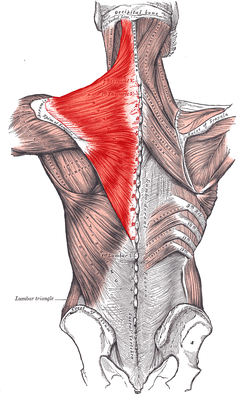česky
Mike Reinold's article explains how muscle imbalance and wrong exercise technique can lead to chronic pain. He writes about a study which shows imbalance between upper and lower trapezius muscles leading to shoulder impingement. I see this problem very often with new Pilates students. They complain of the neck pain. Let's look at this in a little more simple way.
Upper trapezius is the muscle you can feel between back of the neck - from base of your head - to the shoulder to say simply (look at the picture). These muscles are very often overloaded if our pattern of movement is bad when lifting arm, pushing or pulling.
Lower trapezius fibers run between mid spine and a shoulder blade.
Upper traps can lift shoulder blades. Lower traps can lower shoulder blades. So if your upper traps are stronger, your shoulders go up even if they don't suppose to. Like in push ups, press ups or when getting a cup from your cupboard.
One thing I would add to Mike Reinold's article is proper breathing. Most people with shoulder or neck pain just don't breath right. When you see your shoulders rise while breathing you know you are overworking your upper trapezius and inviting pain. Try to open your shoulders wide and breath down into your lower lungs instead into your shoulders or just chest.
If you have ever done STOTT PILATES® you know that breathing, scapular movement and placement of head and neck belong to our basic principles. When you learn a proper technique you can re-learn that bad pattern and use it in your daily life and this I think is a real purpose of Pilates or any functional exercise.
Mike Reinold's article explains how muscle imbalance and wrong exercise technique can lead to chronic pain. He writes about a study which shows imbalance between upper and lower trapezius muscles leading to shoulder impingement. I see this problem very often with new Pilates students. They complain of the neck pain. Let's look at this in a little more simple way.
Upper trapezius is the muscle you can feel between back of the neck - from base of your head - to the shoulder to say simply (look at the picture). These muscles are very often overloaded if our pattern of movement is bad when lifting arm, pushing or pulling.
Lower trapezius fibers run between mid spine and a shoulder blade.
Upper traps can lift shoulder blades. Lower traps can lower shoulder blades. So if your upper traps are stronger, your shoulders go up even if they don't suppose to. Like in push ups, press ups or when getting a cup from your cupboard.
One thing I would add to Mike Reinold's article is proper breathing. Most people with shoulder or neck pain just don't breath right. When you see your shoulders rise while breathing you know you are overworking your upper trapezius and inviting pain. Try to open your shoulders wide and breath down into your lower lungs instead into your shoulders or just chest.
If you have ever done STOTT PILATES® you know that breathing, scapular movement and placement of head and neck belong to our basic principles. When you learn a proper technique you can re-learn that bad pattern and use it in your daily life and this I think is a real purpose of Pilates or any functional exercise.


